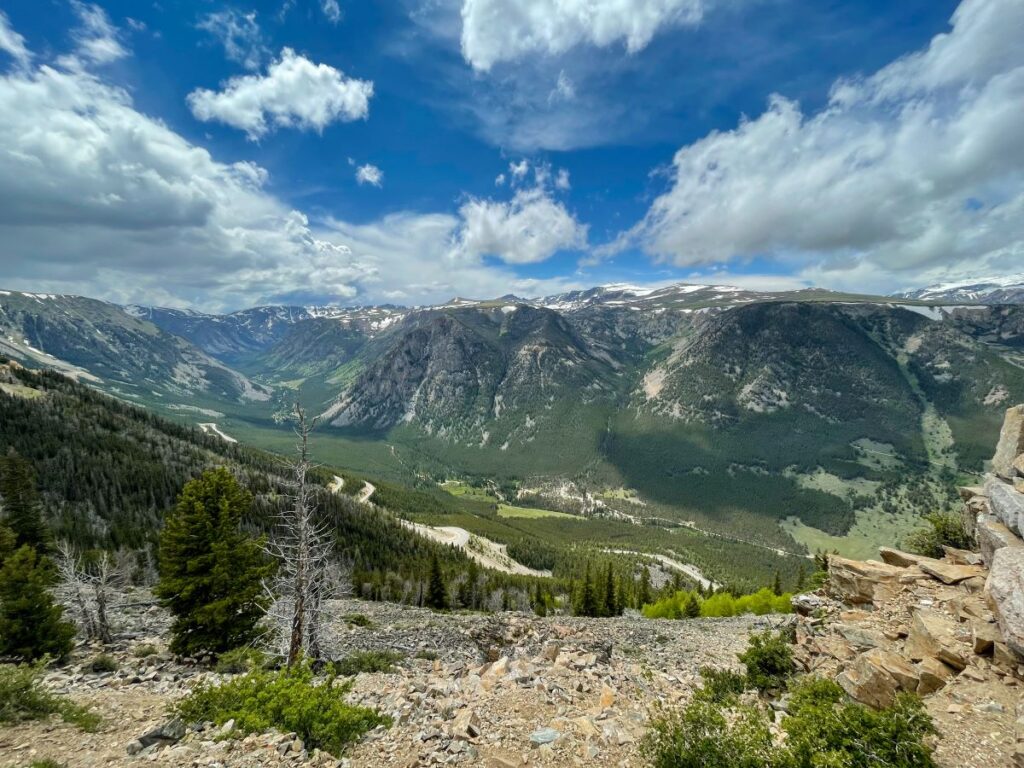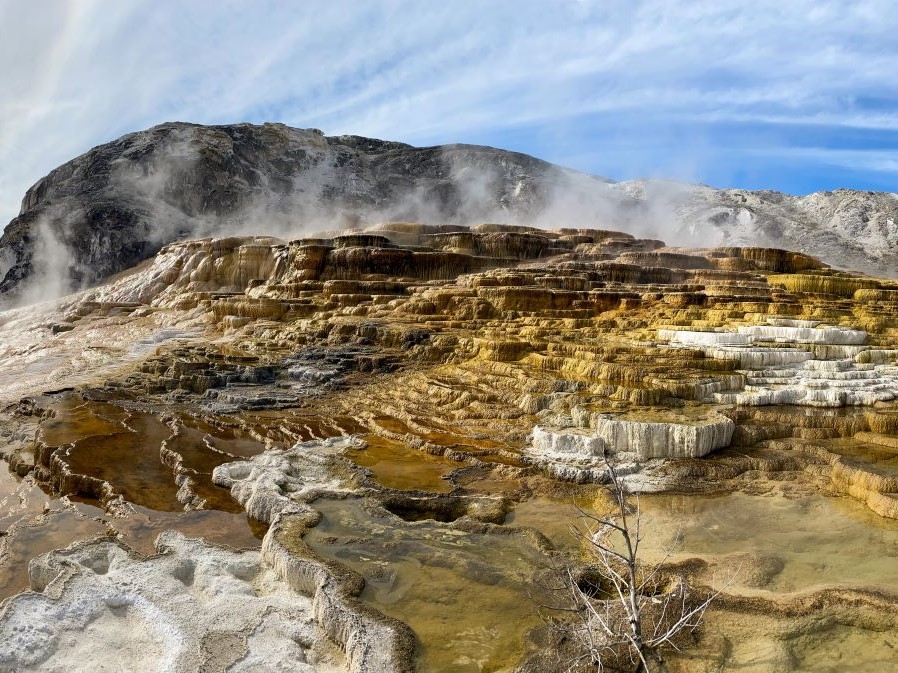Did you know that one of the best places to see lava flows and remnants of volcanic activity is in… southern Idaho?
Craters of the Moon National Monument is one of the most unique areas I have visited. Black lava flows, cinder cones, and sagebrush seem to appear out of nowhere as you approach the area.
In fact, president Calvin Coolidge referred to it as “a weird and scenic landscape, peculiar to itself” when he established the monument in 1924.
If you’re planning a trip out west (perhaps to Yellowstone and/or Grand Teton National Parks) and have an extra day or two to explore, Craters of the Moon National Monument is definitely worth the detour.
This post will cover everything you need to know about visiting Craters of the Moon National Monument, including how to get there, where to stay, and a sample itinerary.
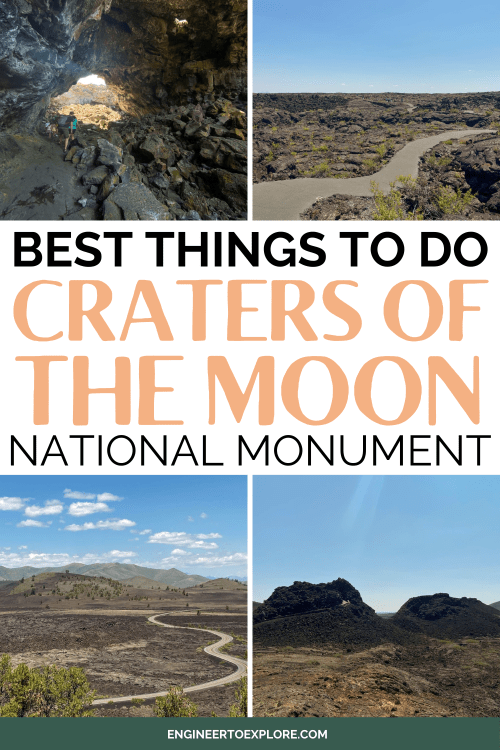
What’s So Special About Craters of the Moon National Monument?
Craters of the Moon National Monument covers over 1100 square miles of lava flows in the Snake River Plain with scattered areas of volcanic cones and sagebrush. The main feature is the Great Rift, a 52-mile crack in the Earth’s crust.
8 eruptive episodes that occurred between 15,000 and 2000 years ago formed the volcanic landscape here. You can explore inferno cones, spatter cones, lava flows, lava caves, and more.
Craters of the Moon was also named an International Dark Sky Park due to the lack of light pollution in the area.
Craters of the Moon is quite literally in the middle of nowhere, and provides scenery that is “otherworldly,” similar to the surface of the moon. NASA astronauts were even trained here in 1969 before going to the moon!
And since this area is designated as a National Monument instead of a National Park, crowds will be much lower here.
If you’re in the area, it is definitely worth a visit!
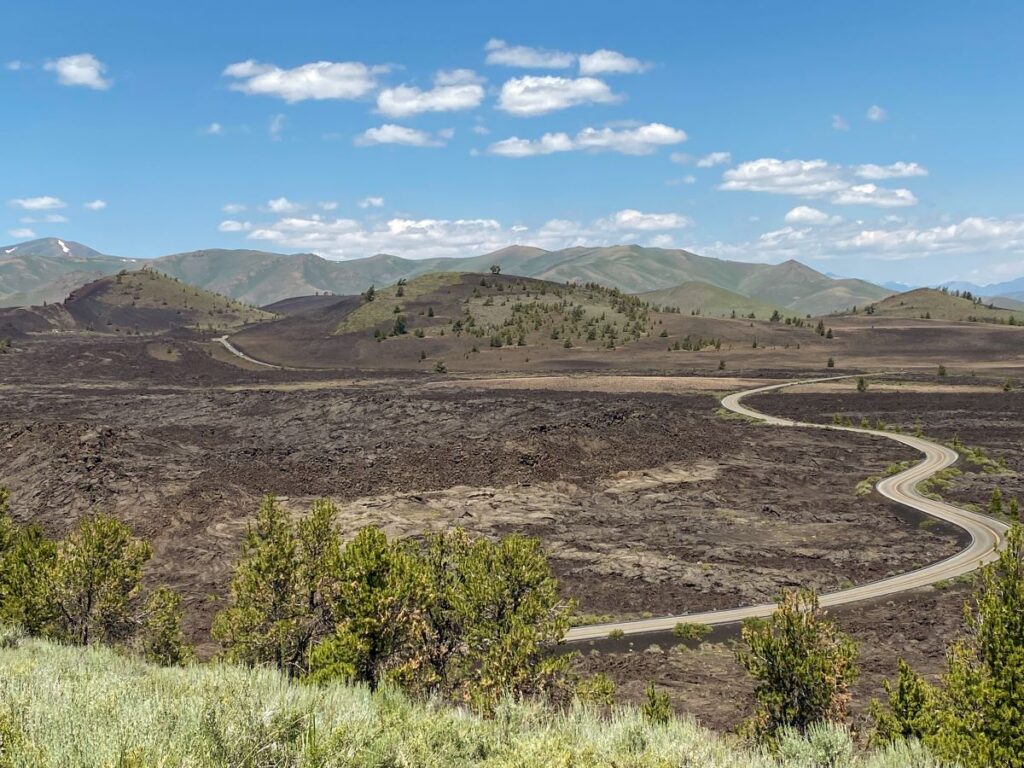
The Best Time to Visit Craters of the Moon National Monument
The best time to visit Craters of the Moon National Monument is between June and September when it is warm and dry. The main park road, Loop Road, is closed in the winter between November and April/May.
Summer crowds are nowhere near as high as some of the other nearby National Parks. We went in early July and were still easily able to find parking midday.
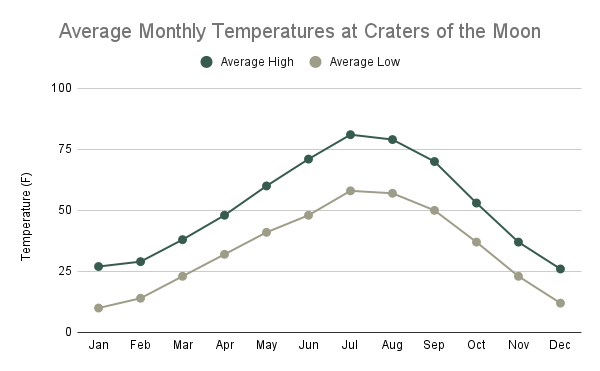
How to Get to Craters of the Moon National Monument
Craters of the Moon is located in southern Idaho in quite literally the middle of nowhere. There are no major airports nearby and you’ll definitely need to rent a car to get here.
Boise is the closest airport, but it is relatively small and flights can be expensive. Salt Lake City is probably your most affordable option, but Bozeman and Billings could work too.
Craters of the Moon makes a great little day trip if you are on a road trip to or from Yellowstone and/or Grand Teton National Parks. The entrance to the monument is off of US Highway 20/26/93.
Here are drive times to Craters of the Moon National Monument from popular locations:
- Boise, ID: 170 miles / 2.5 – 3 hours
- Idaho Falls, ID: 86 miles / 1.5 hours
- Twin Falls, ID: 90 miles / 1.5 hours
- Pocatello, ID: 102 miles / 1.5 hours
- Salt Lake City, UT: 263 miles / 4 hours
- Bozeman, MT: 303 miles / 4.5 – 5 hours
- Billings MT: 445 miles / 6.5 hours
- Jackson, WY & Grand Teton National Park: 175 miles / 3 – 3.5 hours
- Yellowstone National Park (West Entrance): 194 miles / 3 – 3.5 hours
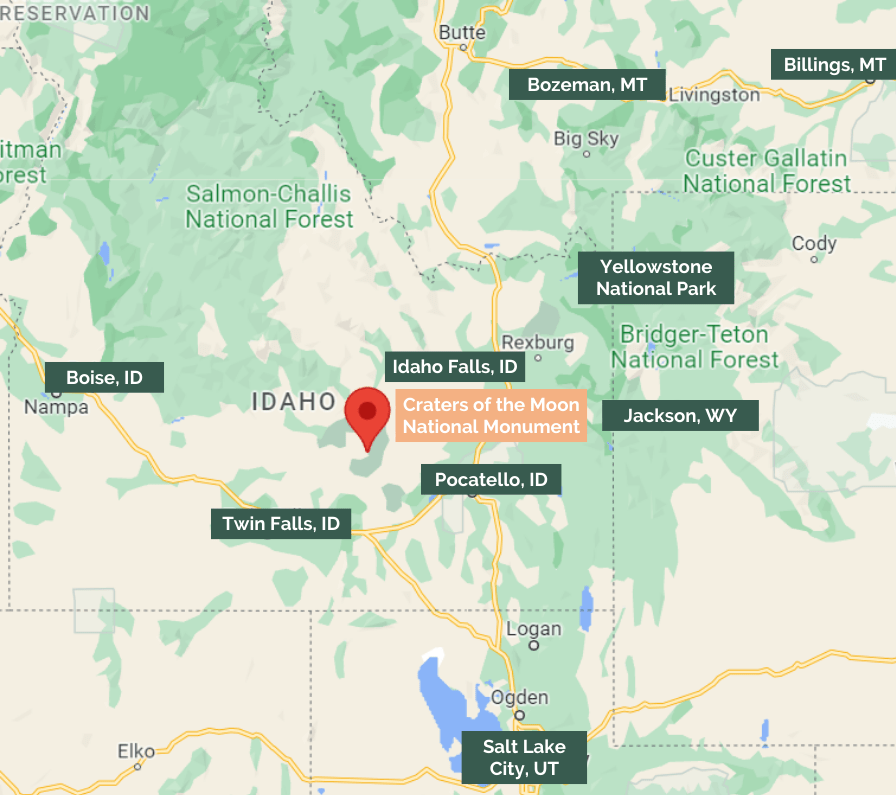
Where to Stay Near Craters of the Moon National Monument
The closest town to Craters of the Moon is Arco, but accommodations and amenities are severely limited here. I’m talking literally only 2 motels and they are very very basic.
I recommend staying in Twin Falls, Pocatello, or Idaho Falls. Twin Falls and Pocatello are great if you’re heading south to Salt Lake City and Idaho Falls is convenient if you’re heading north toward Bozeman.
There are plenty of hotel options in either city. We stayed at the Best Western Driftwood Inn in Idaho Falls and I would recommend it!
Camping at Craters of the Moon National Monument
The Lava Flow Campground is the only campground inside Craters of the Moon National Monument. All sites are first come, first serve and there are no RV hookups.
This campground closes seasonally to vehicles between November and April/May.
Snow camping and backcountry camping are also available in certain areas with a free permit from the Visitor’s Center.
More information on camping can be found on the NPS website here.
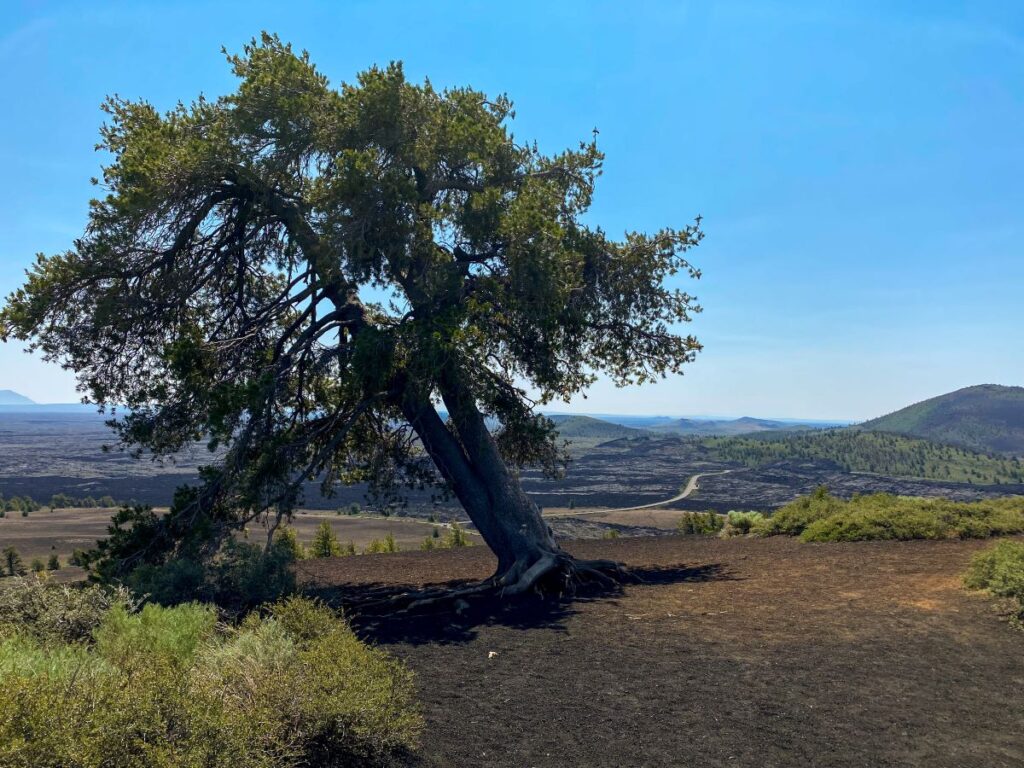
What to Pack for Craters of the Moon National Monument
America the Beautiful Pass: If you plan to visit 3 or more US National Parks that have entrance fees within one year, purchasing this pass will save you money. It’s $80 and gets you into over 2000 NPS-managed lands.
If you plan to visit Yellowstone and Grand Teton National Parks on your trip, this pass will save you money!
Athleta Elation Leggings: I love hiking in leggings. These leggings from Athleta don’t fall down and have just a little bit of compression to hold you in without being uncomfortable.
Biker Shorts: Perfect for those warmer day hikes, biker shorts keep my thighs from chafing while also keeping me cool.
Athleta Conscious Crop Tank Top: These are my favorite tops to work out in, hike in, and do pretty much everything in. Great coverage, easy to layer, and they’re the perfect length to wear with high-waisted leggings or bike shorts.
Dry-Fit Hiking Tops: I like to bring a few different short and long-sleeve dry-fit tops to layer for hikes. Your hike might start out chilly if you get an early start, and elevation changes can drastically change the ambient temperature. If you are also susceptible to sunburns, these tops can protect your arms and shoulders from the direct sun (since shade is non-existent here!).
Nalgene 32-oz Water Bottles: Cheap, lightweight, easy to clean, and hold a ton of water. I seriously never leave my house without one!
You won’t find me carrying a heavy, overpriced, stainless steel cup or a fancy water bottle with a mouthpiece that’s impossible to clean.
Merrell Moab 3 Hiking Shoes: I have had these shoes for over 4 years and I love them! They have great traction and are comfortable for long hikes at an affordable price point. Good shoes make a huge difference when you’re hiking, especially on muddy or rocky trails.
I sized down half a size from my normal size in these and still have plenty of room for good hiking socks. You will want good shoes for most of the hikes here (especially in the caves), even though they are all short!
Smartwool Hiking Socks: I know these are pricey, but they are key to avoiding blisters when hiking. Wool is naturally sweat and odor resistant so these socks will keep your feet dry and smelling good the whole hike!
Hiking Day Pack: I have this cheap one from Amazon and it has worked great on all the short hikes I’ve done in the last 4 years! Instead of getting an expensive day pack, I would spend the money on this Osprey carry-on sized backpack to pack for an entire trip instead.
Sunscreen: This doesn’t really need an explanation. You will be hiking in the desert and there isn’t much shade!
Picnic Lunch and Extra Water: Besides water fountains and vending machines at the Visitor’s Center, there aren’t any amenities for food and drink here. Pack a lunch and extra water!
Craters of the Moon National Monument Map
Even though Craters of the Moon National Monument covers over 1100 square miles, the areas that are available to explore are pretty small.
There is a 7-mile loop drive with spurs off for scenic spots and short hikes. More details on the highlights listed here are in the next section.
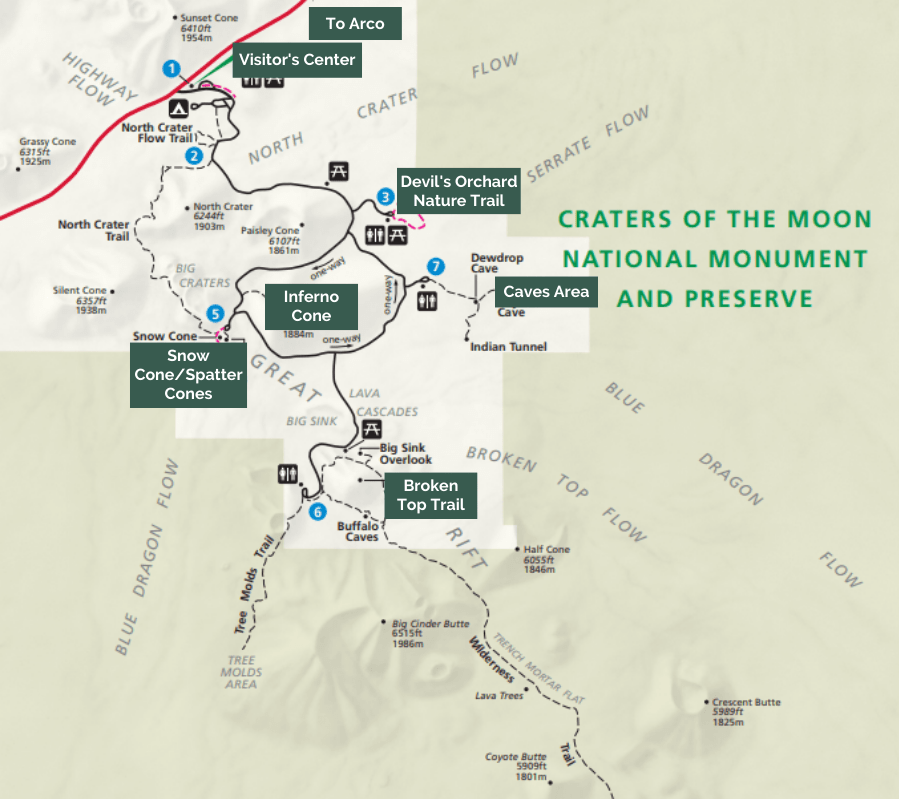
The Best Things to do at Craters of the Moon National Monument
Robert Limbert Visitor’s Center
The Craters of the Moon National Monument Visitor’s Center is a great place to grab a hiking map, cave permit, and explore the museum exhibits. There are restrooms and water fountains here as well.
It’s named after Robert Limbert, the first person to map this area over a century ago!
7-Mile Scenic Drive on Loop Road
The 7-mile scenic drive is a one-way driving loop that goes around the park. All of the hikes and attractions spur off this road.
Loop road is closed from November – April or May.
Bring extra water inside your car as there is none along the road!
Inferno Cone
Enjoy a short but steep climb up a barren cinder cone with 360-degree views of the Great Rift, Pioneer Mountains and Snake River Plain at the Inferno Cone Trail. This trail is 0.4 miles round trip with 164 feet of elevation gain.
The views are absolutely incredible at the top and are well worth the climb! On a clear day, you can even see the Teton Mountain Range 100 miles to the east.
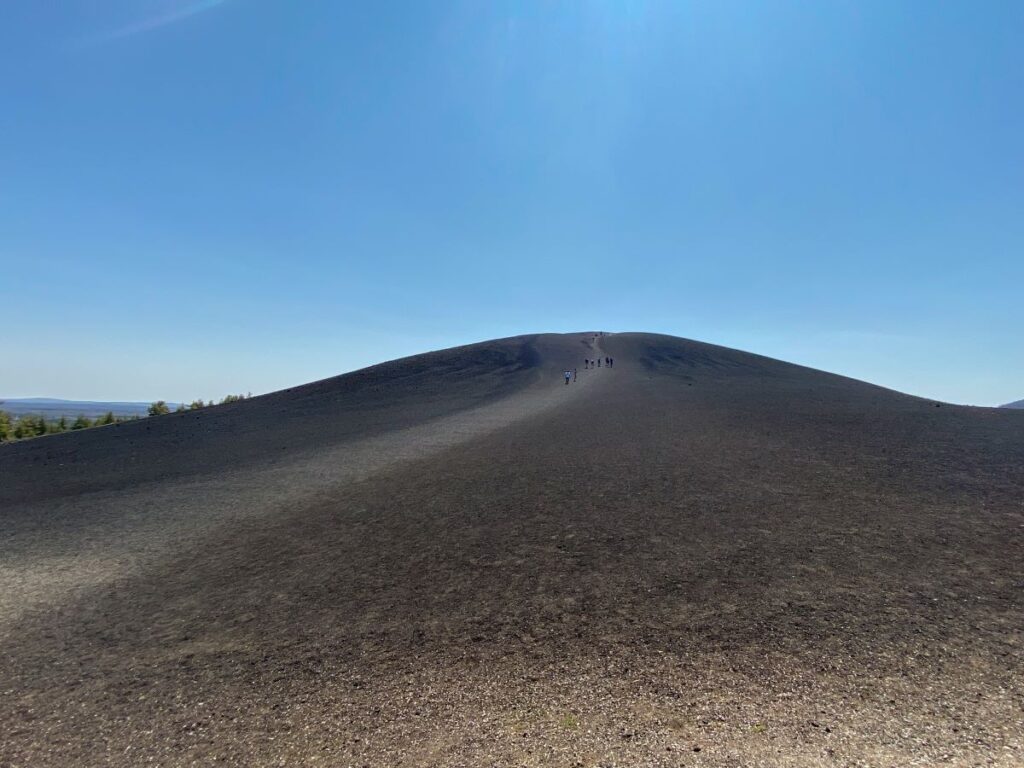
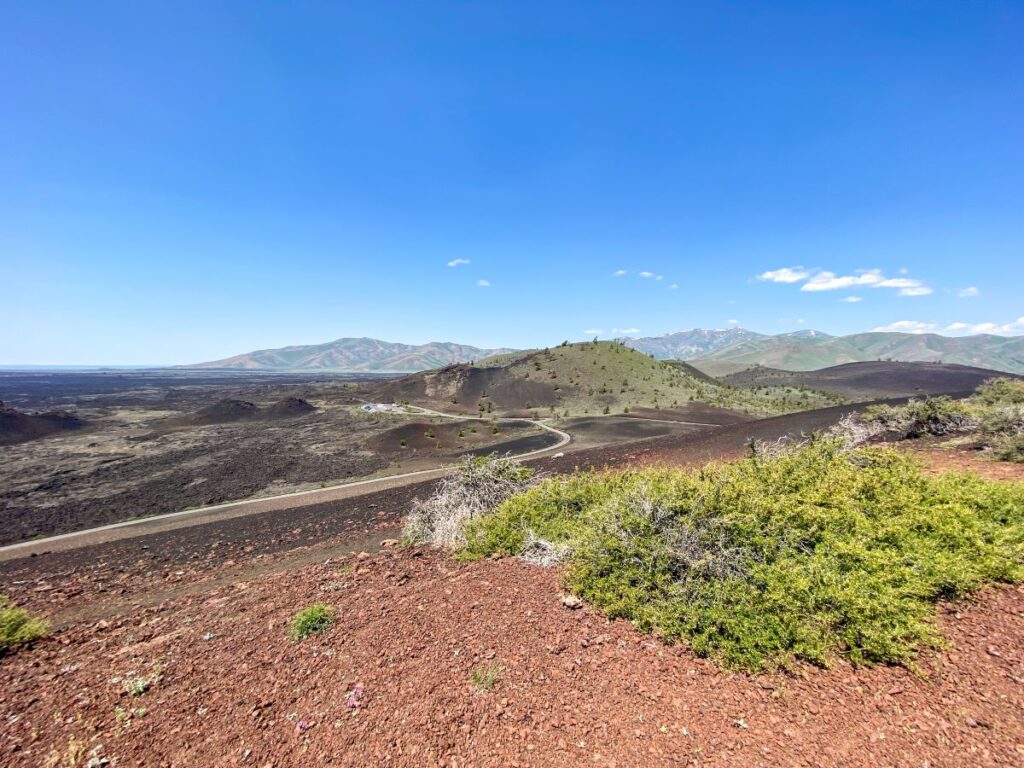
Snow Cone and Spatter Cones
The snow cone and spatter cones are just a short walk from the 7-mile loop road. You can walk up and see inside the vents of these mini volcanoes!
The snow cone still had snow inside even in July!
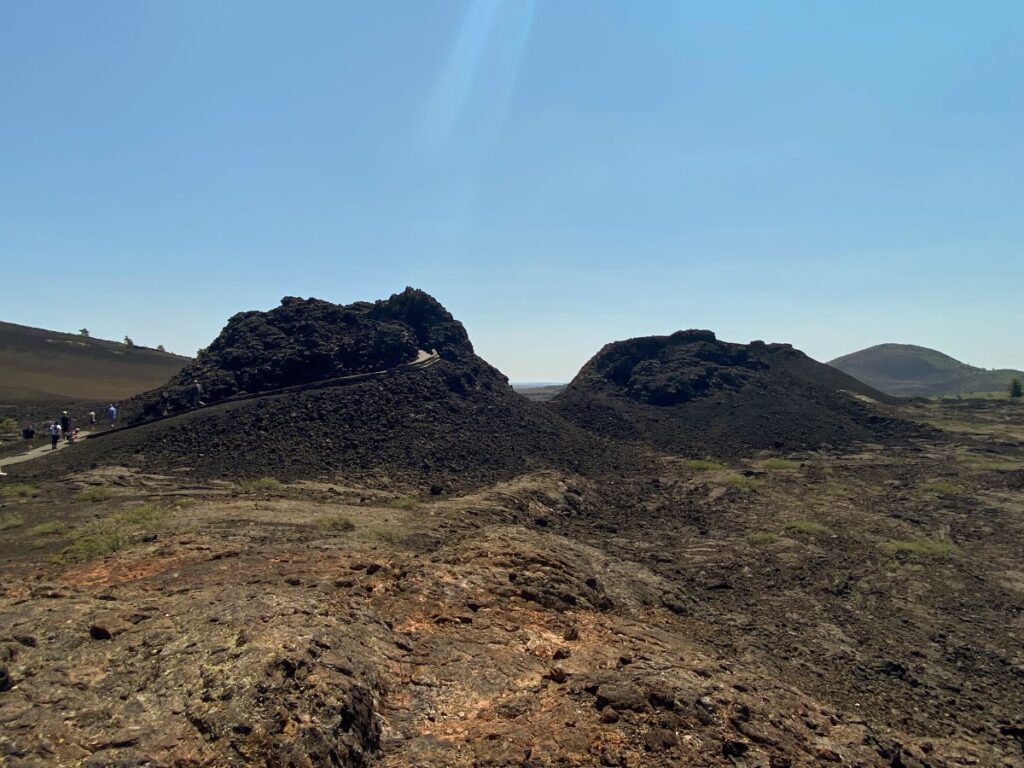
Dew Drop and Indian Caves
You can explore the inside of lava flow caves in this area. My favorite was the Indian Tunnel, where you can hike down inside the cave and come out the other side. Native Americans used this cave for shelter since it had a water source inside.
It is a 0.8 mile hike out across lava fields to this area. There is negligible elevation gain, but you will be in full sun so bring water and sunscreen!
You’ll need to get a free cave permit at the Visitor’s Center before entering any cave. Cave permits protect sensitive bat populations, so you’ll just have to answer a short questionnaire to get one.
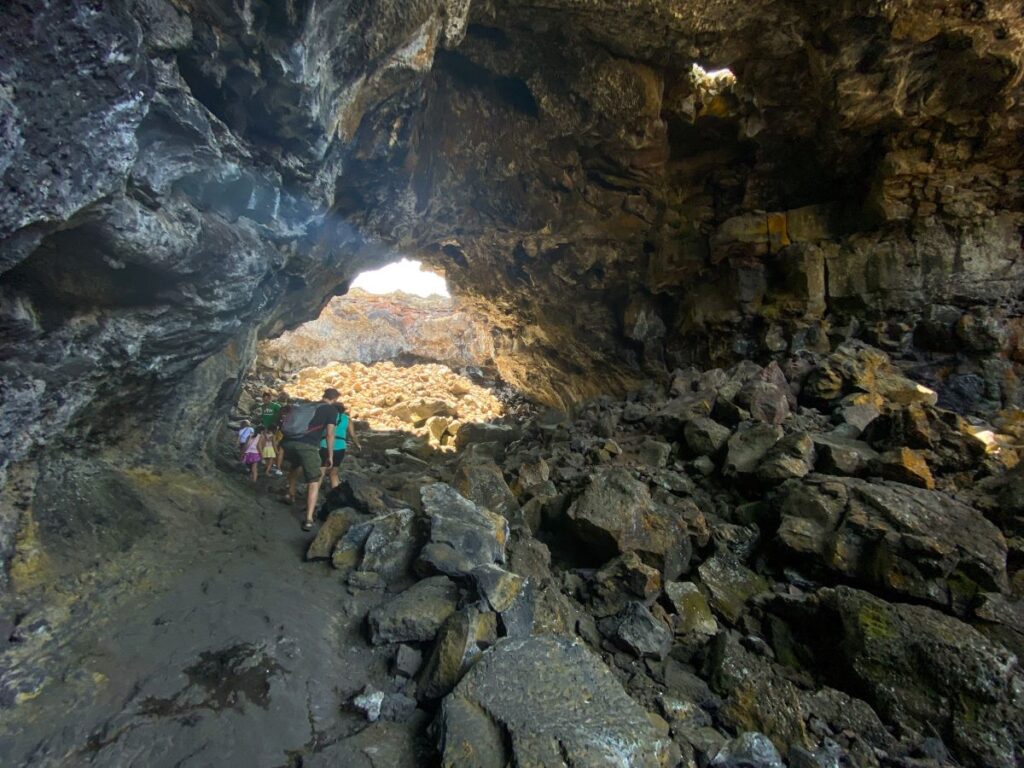
Broken Top Trail
The Broken Top Trail is a 1.8-mile loop trail with 242 feet of elevation gain. You’ll see every type of volcanic characteristic in Craters of the Moon at the various overlooks along this trail.
Part of this trail was closed when we visited, so we hiked about half of it up to the Big Sink Overlook.
One of my favorite parts of this trail were the evenly-spaced wildflowers growing on top of the lava fields! Since there is so much competition for water and sunlight, the flowers cannot grow close together.
It blew my mind that any type of vegetation could survive in this extreme environment!
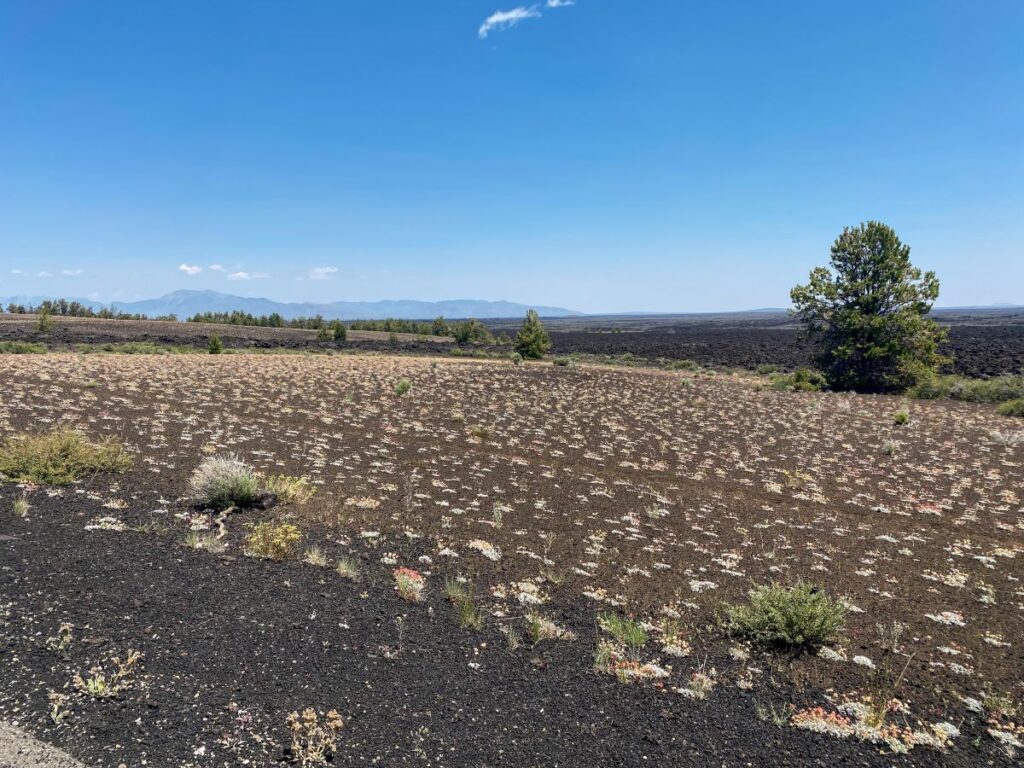
Devil’s Orchard Nature Trail
The Devil’s Orchard Nature Trail is a wheelchair-accessible loop trail through a sea of cinder cones and islands of lava.
Go Stargazing
Craters of the Moon National Monument was designated an International Dark Sky Park in 2017. It is an outstanding place to go stargazing and admire the heavens above.
Do your own stargazing or join an evening ranger-led hike or fireside chat. More information on stargazing and a calendar of events can be found on the NPS website here.
The Idaho Falls Astronomical Society also hosts a “Star Party” every spring and fall at Craters of the Moon.
How Much Time Do You Need at Craters of the Moon National Monument?
You really only need a half-day to explore Craters of the Moon National Monument. With this amount of time, you’ll be able to do the 7-mile scenic drive, hike up the Inferno Cone, see the snow cone and spatter cones, and explore the lava caves.
If you want to do more hiking and/or stargazing, I would reserve a full day.
There are some longer day hikes that I didn’t mention above, but they are outlined in the park map you’ll get at the Visitor’s Center.
I’ve also listed them below for convenience:
- North Crater Trail: 3.5 miles, 758 feet of elevation gain, strenuous
- Tree Molds Trail: 2 miles, 108 feet of elevation gain, easy
- Wilderness Trail: 8 miles, 492 feet of elevation gain, strenuous
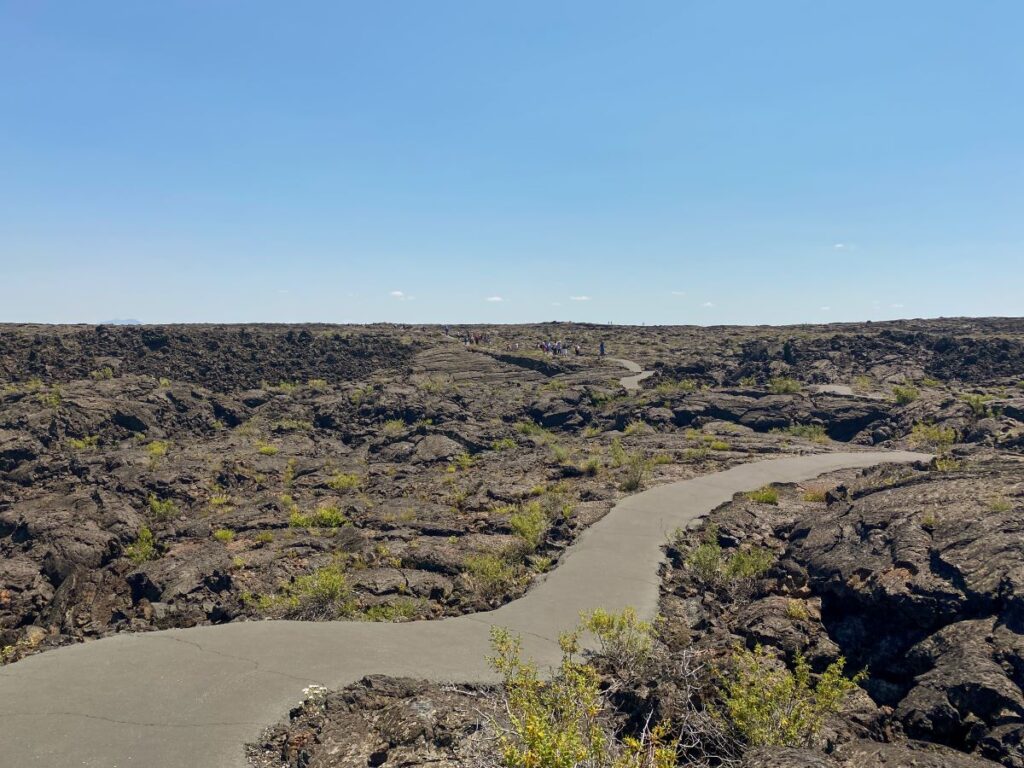
Helpful Tips for Craters of the Moon National Monument
There are no restaurants or accommodations inside Craters of the Moon National Monument, except for restrooms and water fountains at the Visitor’s Center and pit toilets at some trailheads. I highly recommend packing a picnic lunch and snacks with you.
If you’re coming from Idaho Falls, there are no gas stations or restaurants between Idaho Falls and Arco. Make sure you have a full tank of gas and supplies for a picnic lunch before you leave Idaho Falls.
It costs $20 to enter Craters of the Moon National Monument, unless you have the America the Beautiful Annual National Park Pass. It’s $80 and will get you into all National Parks and federal lands for 1 year.
If you’re planning on visiting Grand Teton and Yellowstone National Park along with your visit to Craters of the Moon, the pass will save you money!
You likely won’t have cell signal here, so download any maps ahead of time.
The hikes and attractions at Craters of the Moon are all in full sun, so bring sunscreen and a lot of water!
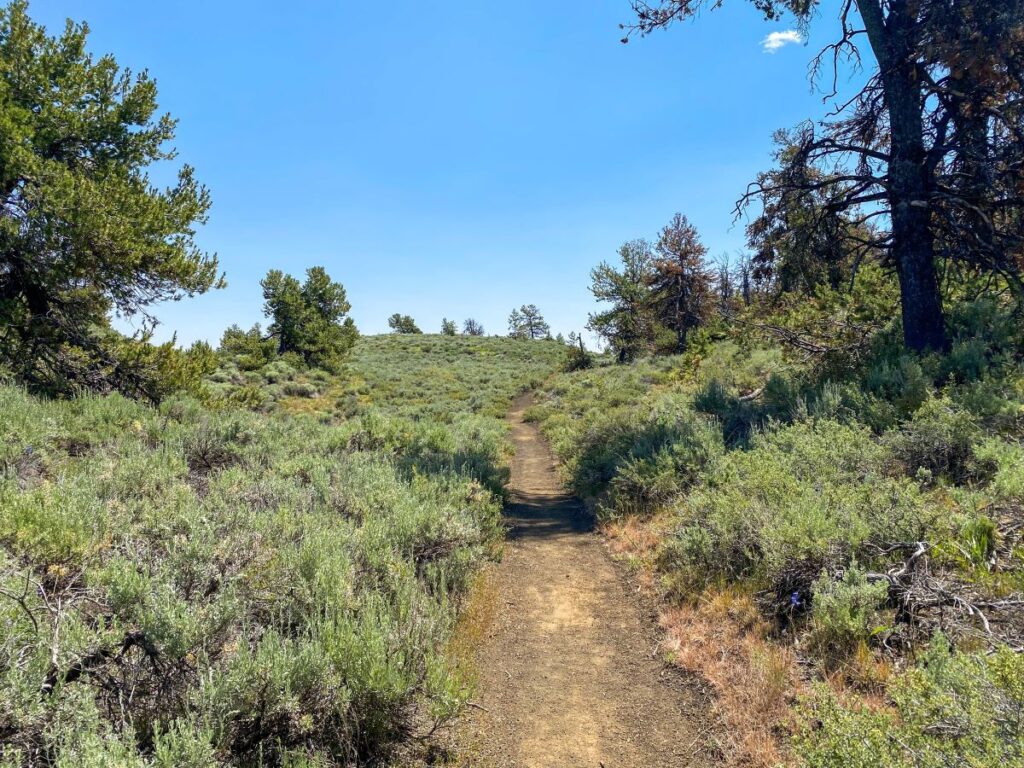
Craters of the Moon National Monument Itinerary
Here’s how I would structure a half-day or a full day in Craters of the Moon National Monument.
Craters of the Moon Half-Day Itinerary
You can start this half-day itinerary in the morning or afternoon. It will be cooler in the morning for hiking, but if that doesn’t fit your trip agenda, coming here midday is fine as well!
Here’s how I would lay out a half-day at Craters of the Moon as you make your way around the 7-mile Loop Road:
- Enter the park and stop at the Visitor’s Center for a map and cave permit
- Start driving the 7-mile Loop Road until you get to Inferno Cone
- Hike up Inferno Cone and take in the view
- Visit Snow Cone and Spatter Cones
- Keep driving on Loop Road until you get to the caves area
- Hike out to Dewdrop Cave and Indian Tunnel
- On your way out of the park, stop at the Devil’s Orchard Nature Trail
Fit in a picnic lunch whenever you get hungry (there are picnic tables and benches scattered throughout the park) and head to your next destination!
The EBR-1 Atomic Museum is just east of Arco and makes a nice addition to your Craters of the Moon itinerary. This is the site of the world’s first nuclear power plant. It’s open 9-5 every day, is totally free, and is only 40 minutes away from the park. Check it out on your way to or from the park, or escape the midday heat and break up your day of hiking!
Craters of the Moon 1-Day Itinerary
With 1 full day in Craters of the Moon, you’ll be able to see all the highlights, do a longer hike, and go stargazing.
Morning: Enter the park and stop at the Visitor’s Center for a map and cave permit. Start driving the 7-mile Loop Road until you get to Inferno Cone. HIke up Inferno Cone and admire the view from the top. Visit the Snow Cone and Spatter Cones.
Midday: Eat your picnic lunch and choose between the Tree Mold or Broken Top Loop trails for an afternoon hike. Both trailheads are at the same location on your way around Loop Road.
Afternoon: Keep driving on Loop Road until you get to the caves area. Hike out to Dewdrop Cave and Indian Tunnel. On your way out of the park, stop at the Devil’s Orchard Nature Trail.
Evening: Grab dinner in Arco or near your accommodations. If you’re camping at Craters of the Moon, wait for nightfall and go stargazing.
If you’re staying in Idaho Falls or Twin Falls, you could always start this itinerary later in the day so you’re in the park at night for stargazing.
You could also visit the EBR-1 Museum in the morning or midday (a great way to escape the heat around lunchtime) and come back to the park later for hiking and stargazing.
Other Attractions Near Craters of the Moon
LIke I mentioned above, Craters of the Moon National Monument is literally in the middle of nowhere. So there aren’t really nearby attractions that aren’t hours away (aka, Yellowstone and Grand Teton National Parks).
If you’re coming from or staying in Pocatello or Idaho Falls, you’ll pass through the small town of Arco, about 20 minutes from Craters of the Moon. The Idaho National Lab is out here as well. If you are a science nerd and/or a Cold War history buff, Arco will be interesting to you.
There are a few points of interest near Arco that you might find worthy of a quick stop.
EBR-1 Atomic Museum
The EBR-1 (Experimental Breeder Reactor) was the world’s first nuclear power plant. The site is now preserved as a museum where you can learn all about the history and physics behind nuclear reactors.
The museum is completely free and open from 9-5 every day. It’s located 20 minutes east of Arco.
We honestly wouldn’t have known about it if it wasn’t for the huge “Free Atomic Museum” billboards on the side of the road. We stopped here after our visit to Craters of the Moon and it was definitely worth it for us!
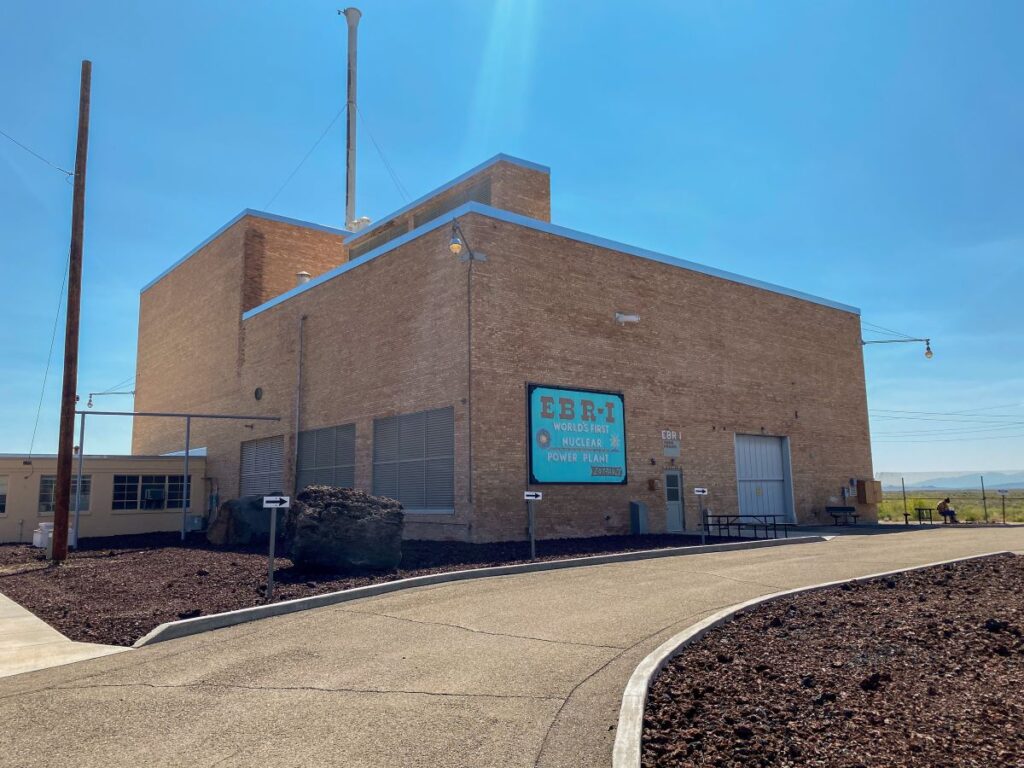
Number Hill
This isn’t really an attraction per say, but more of a point of interest. It’s tradition at Arco High School for each graduating class to paint their graduation year on Number Hill.
If you’re driving through Arco and wondering why those numbers are painted on the hill, that is why!
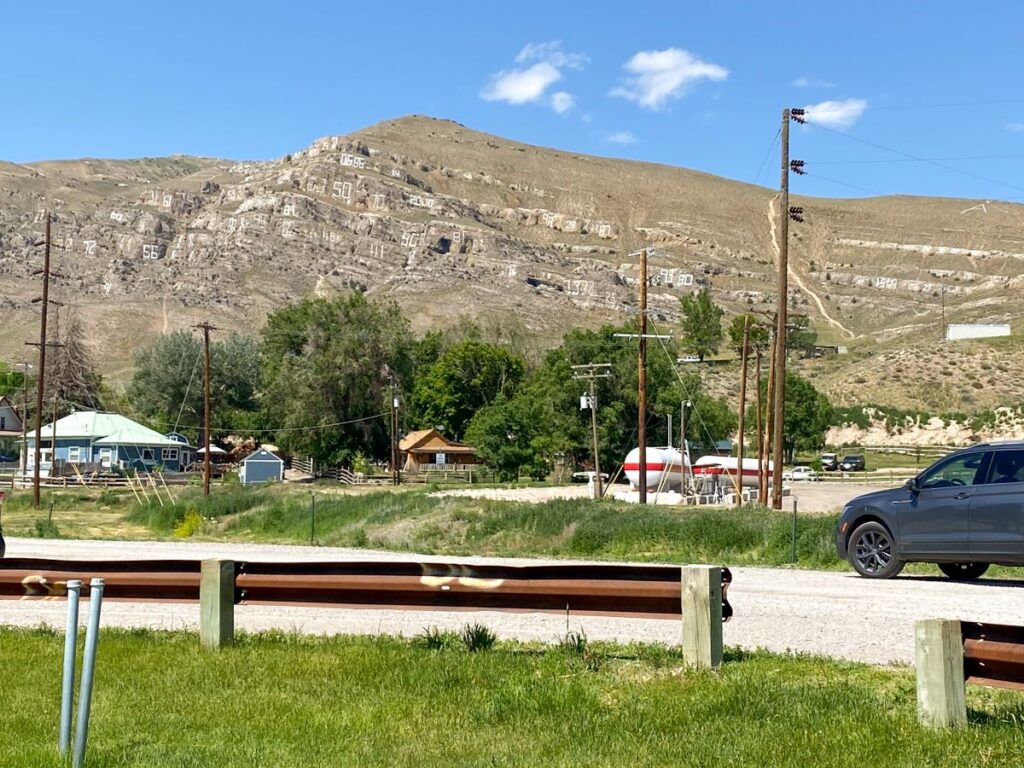
Bottolfsen Park
Another point of interest is a park commemorating the history of Arco being the first town to be successfully powered by nuclear energy. There is a sign documenting the history, which is pretty cool.
Do you have plans to visit Craters of the Moon National Monument? Let me know if you found this guide helpful in the comments below!
-Megan

